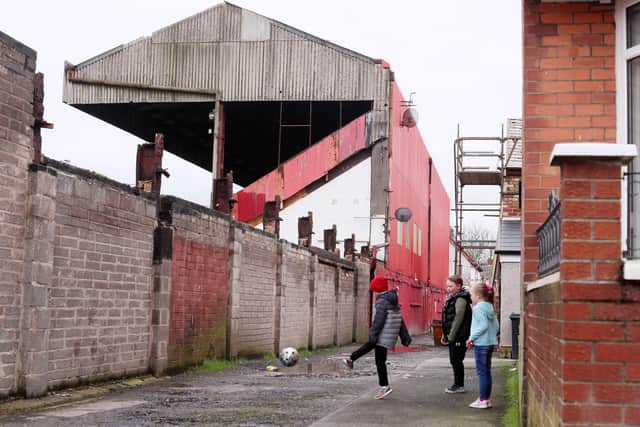Henry McDonald: Fans on both sides of divide agree that football stadiums are a disgrace


Before that announcement it appeared that Irish football clubs were going to lose the multi-million scheme that could have redeveloped local stadia.
The minister’s initial decision to halt the funding while at the same approving of millions to redevelop the GAA’s Casement Park in west Belfast came under fierce criticism within the local football community.
Advertisement
Hide AdAdvertisement
Hide AdHowever, some of that criticism clouded the real issue and indeed the cause of the Irish League by suggesting her original determination was motivated by sectarianism. Because it clunkily characterised the policy as one of pitting the allegedly Catholic-Nationalist GAA against an allegedly Protestant-Nationalist Irish Football community. Which to those who follow and love the Irish League is an objectionable, inaccurate stereotyping of the local sport.
An interest declaration at this stage: I am a lifelong Cliftonville supporter who can still remember the darker days when the Troubles in Northern Ireland cast a shadow over the game.
I recall a time when going to matches away from home was often physically perilous and when you could be subjected to attacks involving hand grenades courtesy of the UFF, bricks, bottles, steel so-called ‘Chinese darts’ and even hot coals chucked over us by irate grannies.
On top of the physical violence and threats there was the ubiquitous sectarian chanting and abuse which lasted for decades.
Advertisement
Hide AdAdvertisement
Hide AdIn fairness and in total honesty some of us were not blameless angels either and I am still ashamed of aspects of my own teenage behaviour following the Reds at certain fixtures in the late 70s and early to mid 80s.
Mercifully those days have faded far into the past and the atmosphere around grounds in the 21st century across Northern Ireland has been generally become de-toxified.
The Irish League and the IFA have a code of conduct outlawing sectarian and racial abuse, which by and large the overwhelming majority of fans adhere to. Hooliganism is an extreme rarity and even when there is an odd outbreak of thuggery the fan bases condemn it without equivocation.
In relation to the other important stuff – the quality of the football on the pitch – there has been a marked improvement over the last 10 years or more in the pace, passing and moving in Irish League games.
Advertisement
Hide AdAdvertisement
Hide AdA few weeks ago, on some rare days off I watched for nostalgia purposes reruns of ‘The Big Match’ on ITV4. One of the most striking things about revisiting topflight (then Division One) clashes between the likes of West Ham and Spurs in the 1970s was how much slower the tempo of even English elite football was the time.
It also hit me that if you could time travel one of the current leading Irish League football teams back to land-of-the-seventies given their pacey play they could give these top English sides from those days a real run for their money on the field.
Whatever side you support at whichever level in Irish League football there is plenty to be proud of about the local game these days.
As someone who has spent far too many tears and treasure watching often disinterested multi-millionaire English Premiership footballers sometimes casually lose games in the most lucrative league in the world the Irish League by contrast gives the ordinary fan real value for money.
Advertisement
Hide AdAdvertisement
Hide AdFor instance, I remember one scintillating Saturday afternoon at Solitude attending a thrilling 3-3 draw with Linfield about a decade ago. Later that evening I sailed across the Irish Sea for the Merseyside derby which ended the next day in a drab 0-0 draw.
The entrance fee at the North Belfast stadium cost £10 while it was the guts of £50 to enter Goodison Park 24 hours later. I know which game I was short changed in.
The one aspect of Irish League football which is still a crying shame is the dilapidated nature of so many of stadia. From decaying, rotting stands like the old main stand at Solitude to the vile toilets at other grounds across Northern Ireland the state of the stadiums has long been a disgrace.
Fans regardless of their religious or political allegiances were and are united in seeing a province wide upgrade of their grounds.
Advertisement
Hide AdAdvertisement
Hide AdThe £32.6 million initially promised to transform these grounds was aimed at giving supporters decent surroundings to watch their teams in safety, comfort, and dignity. The Northern Ireland Football League’s tenacious campaign under Gerard Lawlor may finally have paid dividends. However, to depict that struggle was one tainted by sectarianism is to dengrate that achievement.
To refract that battle through the prism of sectarian division was something clubs and their fans didn’t need in forcing the minister’s U-turn.
Other opinion articles here:
Advertisement
Hide AdAdvertisement
Hide Ad• Anna Faro: Big surge in empty pews just another problem for churches that were already struggling pre-pandemic
• Ruth Dudley Edwards: Doug Beattie’s engagement policy gets a boost from Alliance